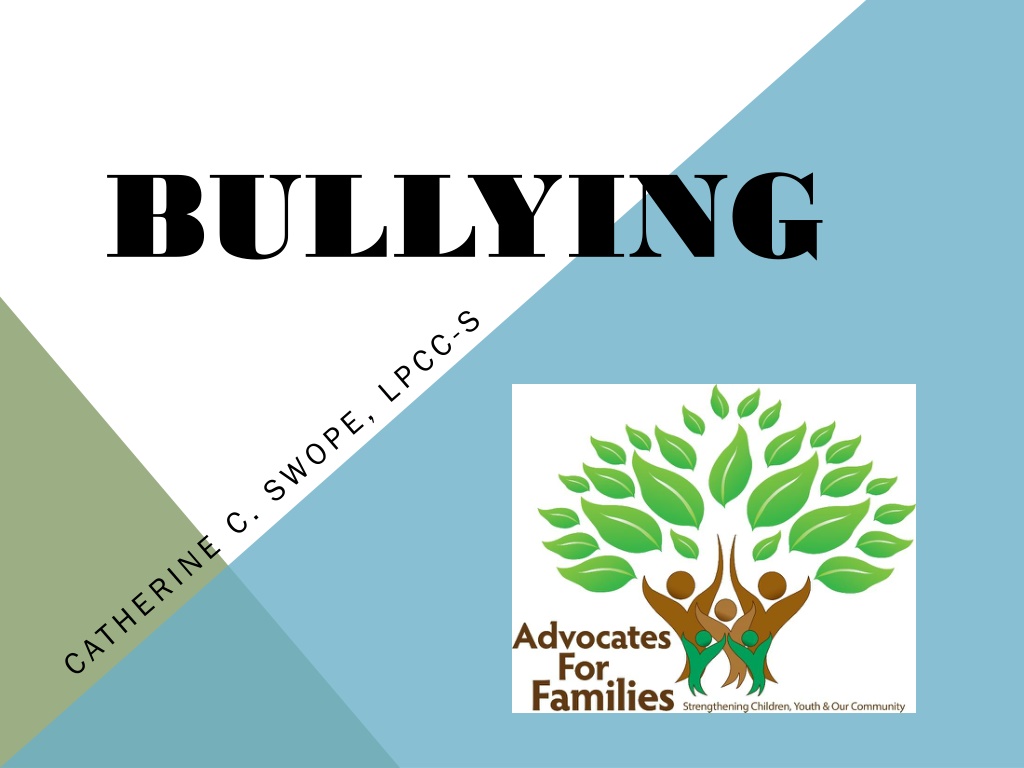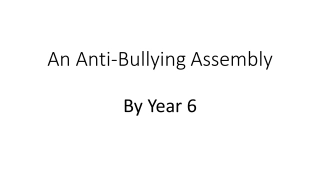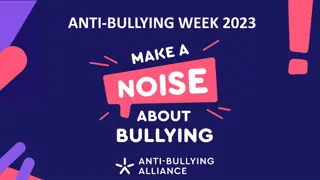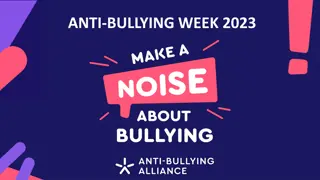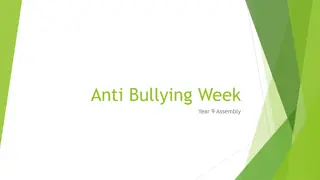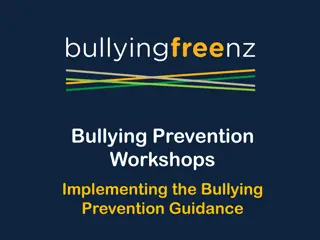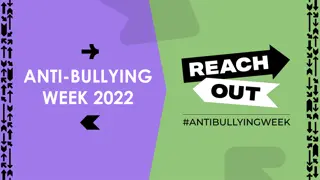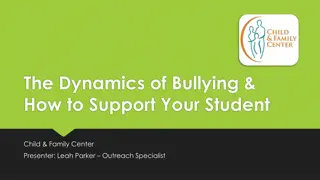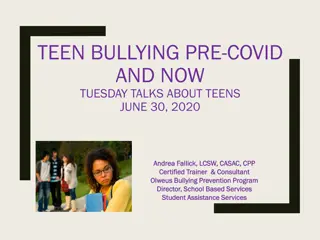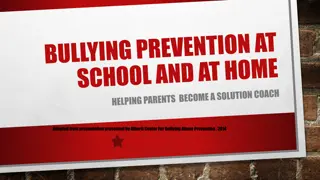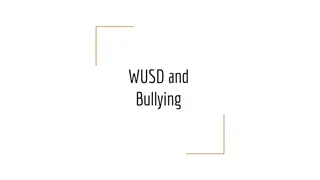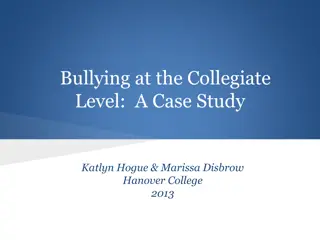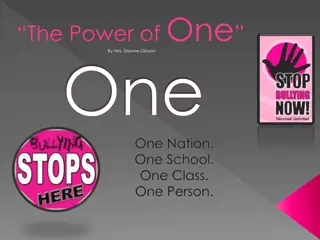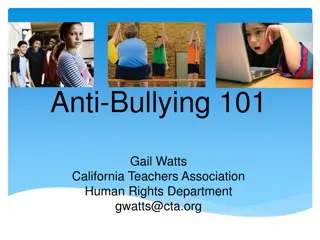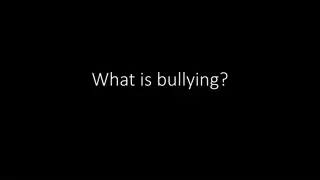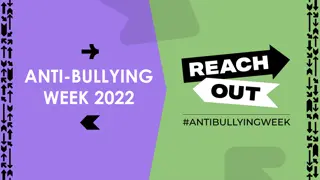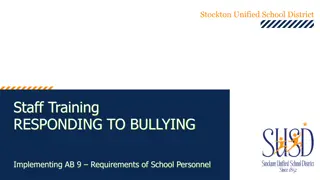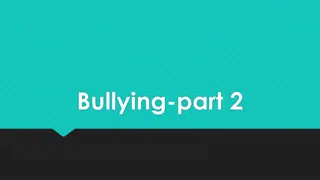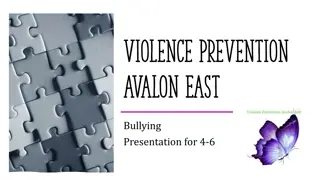Understanding Bullying and Its Impact
Bullying is an act of violence involving an imbalance of power, intentional hurtful acts, and behaviors against others. It affects individuals in various ways, including physical, verbal, and emotional harm. Educating oneself on bullying is crucial as it impacts everyone, not just teenagers. Recognizing the different forms of bullying, such as physical, verbal, and relational, is essential in combating this pervasive issue.
Download Presentation

Please find below an Image/Link to download the presentation.
The content on the website is provided AS IS for your information and personal use only. It may not be sold, licensed, or shared on other websites without obtaining consent from the author. Download presentation by click this link. If you encounter any issues during the download, it is possible that the publisher has removed the file from their server.
E N D
Presentation Transcript
WHY ALL THE HYPE? I M NOT WORKING WITH TEENS, SO THIS DOESN'T APPLY TO ME! BULLYING EFFECTS EVERYONE, ONE WAY OR ANOTHER. YOU MAY NOT WORK WITH TEENS BUT THE TREND IS FOR YOUNGER YOUTH TO DEAL WITH THIS ISSUE.
WHAT IS BULLYING?
WHAT IS BULLYING? Definition: Definition: Bullying is an act of violence that Bullying is an act of violence that involves the imbalance of power involves the imbalance of power between the bully/ between the bully/ies It is intentional, repeated hurtful It is intentional, repeated hurtful acts, words or other behaviors acts, words or other behaviors committed by one or more persons committed by one or more persons against another (or group of others) against another (or group of others) in an obvious or subtle way. in an obvious or subtle way. ies and victim/s. and victim/s.
WHAT IS BULLYING? Physical: Physical: hitting, pushing, pinching, kicking, hitting, pushing, pinching, kicking, spitting, hair pulling, taking or spitting, hair pulling, taking or damaging someone else s damaging someone else s property, taking money from a property, taking money from a person, assault or sexual assault. person, assault or sexual assault.
WHAT IS BULLYING? Verbal / Communicative : Verbal / Communicative : using words to hurt or humiliate using words to hurt or humiliate another person (this is in all forms of another person (this is in all forms of communication such as social communication such as social media, creating songs, taunts, media, creating songs, taunts, emails, texting or voice mail), emails, texting or voice mail), menacing or terrorist threats, menacing or terrorist threats, spreading rumors, sexual spreading rumors, sexual harassment. harassment.
WHAT IS BULLYING? Relational / Emotional: Relational / Emotional: trying to convince peers to trying to convince peers to exclude, upset, embarrass or exclude, upset, embarrass or reject another person, cutting reject another person, cutting another off from social another off from social connections and friends. connections and friends.
WHAT IS BULLYING? Sexual: Sexual: sexual bullying singles out a person sexual bullying singles out a person because of gender or sexual because of gender or sexual orientation and demonstrates orientation and demonstrates unwarranted or unwelcome sexual unwarranted or unwelcome sexual behavior. Examples include: sexual behavior. Examples include: sexual comments, abusive comments, comments, abusive comments, urination on another person, urination on another person, unwanted physical contact. unwanted physical contact.
WHAT IS BULLYING? Racial: Racial: racial bullying involves rejection racial bullying involves rejection or isolation of a person because or isolation of a person because of ethnicity. Examples include: of ethnicity. Examples include: gestures, racial slurs or taunts, gestures, racial slurs or taunts, name calling, making fun of name calling, making fun of customs/skin color/accent/food customs/skin color/accent/food choices. choices.
WHAT IS BULLYING? Reactive: Reactive: someone who has been someone who has been repeatedly bullied, now becomes repeatedly bullied, now becomes the bully, hurting others the way the bully, hurting others the way they have been hurt in the past. they have been hurt in the past. Striking before they become the Striking before they become the target again. target again.
IN THE NEWS 12/3/2021 Beautiful 10 year old Isabella Tichenor died by suicide weeks after serious Dept of Justice report is filed against her school district. Her radiant smile faded after she began 5th grade.
IN THE NEWS 11/27/2021 Kind, gentle 12 year old Eli Fritchley dies by suicide after years of relentless bullying. Even with all the attacks, he never blamed anyone and instead would shine compassion from his gentle soul. Teenager, 16, killed himself after being Teenager, 16, killed himself after being 'relentlessly' bullied for being autistic 'relentlessly' bullied for being autistic and gay and gay Cameron Warwick, 16, struggled with Cameron Warwick, 16, struggled with depression and had autism depression and had autism His mother said he was bullied at school for His mother said he was bullied at school for being gay, after coming out at 12 being gay, after coming out at 12 She said pupils would throw food at him, She said pupils would throw food at him, call him names and trip him up at lunch call him names and trip him up at lunch Cameron was found dead in woods in Cameron was found dead in woods in Fareham Fareham, Hampshire , Hampshire after missing college college after missing
REBECCA SEDWICK TWO GIRLS, A 12 AND 14 -YEAR - OLD, WERE ARRESTED IN A FLORIDA BULLYING CASE AFTER ONE OF THEM ADMITTED ONLINE OVER THE WEEKEND THAT SHE HARASSED A 12 -YEAR -OLD GIRL WHO KILLED HERSELF LAST MONTH, A SHERIFF SAID TUESDAY. (OCT. 15, 2013)
WHO WILL YOU SEE AS AN ADVOCATE AND SUPPORT PERSON TO CHILDREN?
WHO MIGHT YOU ENCOUNTER AS A CASA, COUNSELOR OR SUPPORT TO A YOUTH? 1) Those being bullied 1) Those being bullied
WHO WILL YOU MEET? 2) Those who are 2) Those who are bystanders bystanders
WHO WILL YOU MEET? 3) The Bully 3) The Bully The Expected Bully The Expected Bully The Unexpected Bully The Unexpected Bully
HELP FOR THE BULLIED
HELP FOR THOSE WHO ARE BULLIED Why don t those Why don t those being bullied tell? being bullied tell?
HELP FOR THOSE WHO ARE BULLIED F E A R F E A R
HELP FOR THOSE WHO ARE BULLIED FEAR of: FEAR of: Retaliation Retaliation Becoming worse Becoming worse Being laughed at further Being laughed at further
HELP FOR THOSE WHO ARE BULLIED It is this same fear that feeds a It is this same fear that feeds a bully. bully. For many of the bullies the purpose For many of the bullies the purpose is control of their world and peer is control of their world and peer groups. groups.
HELP FOR THOSE WHO ARE BULLIED Fear is interest paid on a debt you Fear is interest paid on a debt you may not owe . may not owe . It is this fear that drives a youth to It is this fear that drives a youth to the point of the point of hopelessness hopelessness and helplessness helplessness. . and
HELP FOR THOSE WHO ARE BULLIED Bullying or abuse makes Bullying or abuse makes one feel that no matter one feel that no matter what you say or do, NO what you say or do, NO ONE will listen and it will ONE will listen and it will NEVER change. NEVER change.
HELP FOR THOSE WHO ARE BULLIED Ways to help Ways to help Put away the W Questions Put away the W Questions
HELP FOR THOSE WHO ARE BULLIED LISTEN LISTEN Take time to really hear their story Take time to really hear their story without judgement or the why without judgement or the why questions. They need to know questions. They need to know you are hearing them and you are hearing them and believe them and in them. believe them and in them.
HELP FOR THOSE WHO ARE BULLIED Recognizing the Signs Recognizing the Signs Look for the following evidence if you suspect someone Look for the following evidence if you suspect someone might be a victim of bullying: might be a victim of bullying: Change in appetite or eating habits Change in appetite or eating habits Loss of interest in school and schoolwork, possibly Loss of interest in school and schoolwork, possibly including worsening grades including worsening grades Difficulty going to sleep or staying asleep (insomnia) Difficulty going to sleep or staying asleep (insomnia) Frequent stomachaches, headaches, or other excuses to Frequent stomachaches, headaches, or other excuses to stay home from school stay home from school Sudden withdrawal from family activities Sudden withdrawal from family activities
HELP FOR THOSE WHO ARE BULLIED Recognizing the Signs (cont d) Recognizing the Signs (cont d) Change from happy and secure to moody and Change from happy and secure to moody and depressed depressed Torn or blood Torn or blood- -stained clothes stained clothes Change in the group of girls she usually hangs out Change in the group of girls she usually hangs out with, especially if her friends suddenly stop with, especially if her friends suddenly stop coming around coming around Sudden need for extra money for school lunches Sudden need for extra money for school lunches Increased anxiety Increased anxiety Spending more time on the computer and not Spending more time on the computer and not wanting you to see what she's doing online wanting you to see what she's doing online
HELP FOR THOSE WHO ARE BULLIED Ways to help Ways to help Help the parent/caregiver with Help the parent/caregiver with their reactions their reactions to the bullying to the bullying
HELP FOR THOSE WHO ARE BULLIED Ways to help Ways to help Find a purpose Find a purpose
HELP FOR THOSE WHO ARE BULLIED Ways to help Ways to help List of supporters List of supporters
HELP FOR THOSE WHO ARE BULLIED Ways to help Ways to help Survivor Stories Survivor Stories
HELP FOR THOSE WHO ARE BULLIED Ways to help Ways to help Tools to Stand Tools to Stand
HELP FOR THOSE WHO ARE BULLIED Ways to help Ways to help For verbal use the For verbal use the FAT FAT model: model: F FEAR: don t show the bully any fear, use body as ally. A ATTENTION: don t give the bully any attention, don t look, respond in any way T THINGS: never give material things to the bully, once you give in, it never stops
HELP FOR THOSE WHO ARE BULLIED Ways to help Ways to help For physical bullying For physical bullying The bullied has the right to defend The bullied has the right to defend themselves and need to. If a physically bully themselves and need to. If a physically bully knows the other youth will not fight back, they knows the other youth will not fight back, they will always be a target. will always be a target. Suggest the child takes martial arts training Suggest the child takes martial arts training and instruct parents to ask the instructor to and instruct parents to ask the instructor to teach the child the five most effective self teach the child the five most effective self- - defense (blocking and control) movements. defense (blocking and control) movements.
HELP FOR THOSE WHO ARE BULLIED Ways to help Ways to help For physical bullying For physical bullying Often when a youth stands up for Often when a youth stands up for themselves, others who are marginal themselves, others who are marginal will then befriend the youth who was will then befriend the youth who was being bullied and they can create a being bullied and they can create a group to stand against the bully in the group to stand against the bully in the future future
HELP FOR THOSE WHO ARE BULLIED Ways to help Ways to help For Both types of bullying For Both types of bullying Teach the young person social skills, such as Teach the young person social skills, such as how to connect. how to connect. Give them a list of connection topics and Give them a list of connection topics and questions they can use to ask appropriate questions they can use to ask appropriate personal, family, hobby, music, interest, etc. personal, family, hobby, music, interest, etc. questions. questions.
HELP FOR THOSE WHO ARE BULLIED Ways to help Ways to help For Both types of bullying For Both types of bullying Teach the youth to advocate for Teach the youth to advocate for themselves themselves Teach the parents how to advocate for Teach the parents how to advocate for their youth their youth AND AND Advocate for your kid Advocate for your kid (smile and lean approach) (smile and lean approach)
HELP FOR THOSE WHO ARE BULLIED Ways to help Ways to help Help your youth learn skills to get them Help your youth learn skills to get them into a friendship or social group. into a friendship or social group. This is the goal! Helping them help This is the goal! Helping them help themselves to create friendships and be themselves to create friendships and be a part of a social group, not on the a part of a social group, not on the outside of the social groups. outside of the social groups.
HELP FOR THOSE WHO ARE BULLIED Ways to help Ways to help Simple model Simple model Walk with awareness, calm and confidence Walk with awareness, calm and confidence Feel one way but act another Feel one way but act another Filter hurtful words Filter hurtful words Communicate with others to gain help Communicate with others to gain help Use physical self Use physical self- -defense as a last resort defense as a last resort
HELP FOR THE BYSTANDERS
HELP FOR THOSE WHO ARE BYSTANDERS 60 to 70% of students in schools are 60 to 70% of students in schools are those who are not usually bullied and those who are not usually bullied and do not do the bullying. do not do the bullying. They are not in the top popular group They are not in the top popular group but can float back and forth between but can float back and forth between social groups fairly well. social groups fairly well. These are the followers in school. They These are the followers in school. They follow the trends, the rules and at follow the trends, the rules and at times bullying. times bullying.
HELP FOR THOSE WHO ARE BYSTANDERS Ways to help Ways to help Help them develop a good sense of self Help them develop a good sense of self Help them build and develop their own self esteem. Help them build and develop their own self esteem. Help them build and develop greater depths of Help them build and develop greater depths of empathy by exposing them to stories of those empathy by exposing them to stories of those bullied bullied Give them the same techniques you give the bullied Give them the same techniques you give the bullied so that they can help coach and encourage any so that they can help coach and encourage any who are being bullied. who are being bullied. Help them find other avenues for friendships and Help them find other avenues for friendships and activities. activities.
HELP FOR THE BULLIES
HELP FOR THOSE WHO ARE BULLIES Expected or Blatant Bully Profile: Expected or Blatant Bully Profile: The blatant bully is less than 10% of a student body. The blatant bully is less than 10% of a student body. Usually they get caught 1 out of every 10 acts of Usually they get caught 1 out of every 10 acts of bullying. bullying. Often they are using their bullying to distract Often they are using their bullying to distract themselves from feeling emotions of life themselves from feeling emotions of life situations and therefore lose empathy for their situations and therefore lose empathy for their victims. victims. They often lack basic social skills and therefore do They often lack basic social skills and therefore do not know how to interact well with their peers. not know how to interact well with their peers. They look for fear in others to exploit. They look for fear in others to exploit.
HELP FOR THOSE WHO ARE BULLIES Expected or Blatant Bully Profile: Expected or Blatant Bully Profile: Normal Profile Normal Profile Impulsive, hot Impulsive, hot- -headed, dominant headed, dominant Easily frustrated Easily frustrated Lacking empathy Lacking empathy Lacking social skills Lacking social skills Having difficulty following rules Having difficulty following rules Viewing violence in a positive way Viewing violence in a positive way Physically stronger than other children (this is Physically stronger than other children (this is more a characteristic of boy bullies) more a characteristic of boy bullies)
HELP FOR THOSE WHO ARE BULLIES Expected or Blatant Bully Profile: Expected or Blatant Bully Profile: How to Help How to Help See need for Change See need for Change Help them learn social skills they may Help them learn social skills they may be lacking be lacking Provide Clear Behavioral Expectations Provide Clear Behavioral Expectations That Are Free from Loopholes or That Are Free from Loopholes or Ambiguity Ambiguity Avoid Debates and Arguments Avoid Debates and Arguments (Wrestling Pigs) (Wrestling Pigs)
HELP FOR THOSE WHO ARE BULLIES Expected or Blatant Bully Profile: Expected or Blatant Bully Profile: How to Help How to Help Avoid Repetitious or Standardized Avoid Repetitious or Standardized Responses Responses Reinforce Positive Achievements, but Reinforce Positive Achievements, but Cautiously Cautiously Teach Social Skills Teach Social Skills (emotion regulation, self (emotion regulation, self- -regulation, communication skills & social thinking) regulation, communication skills & social thinking)
HELP FOR THOSE WHO ARE BULLIES Expected or Blatant Bully Profile: Expected or Blatant Bully Profile: How to Help How to Help Don't Drop Your Guard Don't Drop Your Guard Focus on Feelings Rather than Facts Focus on Feelings Rather than Facts Don't Stop at Consequences; Teach Don't Stop at Consequences; Teach Pro Pro- -Social Behavior Social Behavior Teach Social Skills they may be lacking Teach Social Skills they may be lacking
